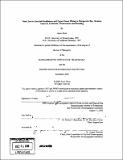Wind, sea ice, inertial oscillations and upper ocean mixing in Marguerite Bay, Western Antarctic Peninsula : observations and modeling
Author(s)
Hyatt, Jason
DownloadFull printable version (52.69Mb)
Other Contributors
Woods Hole Oceanographic Institution.
Advisor
Robert C. Beardsley and W. Brechner Owens.
Terms of use
Metadata
Show full item recordAbstract
Two years of moored oceanographic and automatic weather station data which span the winter ice seasons of 2001-2003 within Marguerite Bay on the western Antarctic Peninsula (wAP) shelf were collected as part of the Southern Ocean Global Ocean Ecosystems Dynamics program. In order to characterize the ice environment in the region, a novel methodology is developed for determining ice coverage, draft and velocity from moored upward-looking acoustic Doppler current profiler data. A linear momentum balance shows the importance of internal ice stresses in the observed motion of the ice pack. Strong inertial, not tidal, motions were observed in both the sea ice and upper ocean. Estimates of upward diapycnal fluxes of heat and salt from the Upper Circumpolar Deep Water to the surface mixed layer indicate almost no contribution from double diffusive convection. A one-dimensional vertical mixed layer model adapted for investigation of mixing beneath an ice-covered ocean indicates that the initial wind event, rather than subsequent inertial shear, causes the majority of the mixing. This work points towards episodic wind-forced shear at the base of the mixed layer coupled with static instability from brine rejection due to ice production as a major factor in mixing on the wAP shelf.
Description
Thesis (Ph. D.)--Joint Program in Oceanography/Applied Ocean Science and Engineering (Massachusetts Institute of Technology, Dept. of Earth, Atmospheric, and Planetary Sciences; and the Woods Hole Oceanographic Institution), 2006. Includes bibliographical references.
Date issued
2006Department
Joint Program in Oceanography/Applied Ocean Science and Engineering; Woods Hole Oceanographic Institution; Massachusetts Institute of Technology. Department of Earth, Atmospheric, and Planetary SciencesPublisher
Massachusetts Institute of Technology
Keywords
/Woods Hole Oceanographic Institution. Joint Program in Oceanography/Applied Ocean Science and Engineering., Earth, Atmospheric, and Planetary Sciences., Woods Hole Oceanographic Institution.